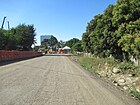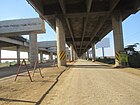Candaba Viaduct
 E1 (North Luzon Expressway)
E1 (North Luzon Expressway)Pampanga River
Calumpit, Bulacan
Pulilan, Bulacan
Candaba Pampanga Viaduct (STA 46+938 – 52+188)
Leighton Asia (third bridge)

The Candaba Viaduct, also known as the Pulilan–Apalit Bridge and the Candaba Pampanga Viaduct, is a 5-kilometer (3.1 mi) viaduct carrying the North Luzon Expressway (NLEX) across the Candaba Swamp in the provinces of Pampanga and Bulacan, Philippines. It consists of six lanes (three northbound and three southbound). It was the longest bridge in the Philippines upon its opening in 1976 until it was surpassed in 2021 by the 8.9 km Cebu–Cordova Link Expressway (CCLEX), making the viaduct the second longest bridge in the country since then. The viaduct was designed by Aas-Jakobsen and built by Construction Development Corporation of the Philippines (CDCP, later renamed to Philippine National Construction Corporation) as part of construction of the whole NLEX.[2][1] [3]
Overlooking Mount Arayat to the east and the Zambales Mountains to the west, the viaduct is raised over Candaba Swamp and Pampanga River by 20 feet (6.1 m), about the same as the current elevation of Bacolor, also in Pampanga, after lahars that resulted from the 1991 eruption of Mount Pinatubo affected the municipality from 1991 to 1995, which keeps the highway open to traffic, even when the swamp gets flooded during the rainy or monsoon season.[4] Lighting, emergency callboxes and CCTVs along the viaduct are powered by solar panels due to the problem of installing power lines within the viaduct.[5]
Route description

The Candaba Viaduct passes over Candaba Swamp and adjacent Pampanga River and connects the provinces of Pampanga and Bulacan.[3] Most of its portions are lined with billboards, rice paddies, and some trees.
The viaduct starts at Barangay Dulong Malabon in Pulilan where there are a few houses located under it and after a few meters, it enters the municipality of Calumpit. After another few meters of passing Calumpit, it enters Pampanga (Apalit) upon passing a U-shaped stream and continues on a straight route. It then passes through an area with palm trees, Apalit Bypass Road (with no junction or exit to serve the bypass road) and Pampanga River, by which the parish church and Apalit town proper are located, visible from the road. A footbridge is located on its southbound lane. The bridge ends after crossing Pampanga River.
History
In 1973, the 50-kilometer extension of the expressway began construction, and in 1974, the viaduct was constructed, which was initially a single bridge. The whole stretch of NLEX was constructed as a component project of the International Bank for Reconstruction and Development under the direction of the Ministry of Public Highways.[2] The project was completed in 1977 and through Presidential Decree No. 1113, President Ferdinand Marcos granted CDCP the franchise to maintain and operate NLEX, including the Candaba Viaduct.[6]
The second bridge became accessible to motorists in 1978.[7]
The operations and maintenance of the whole of NLEX, including Candaba Viaduct, were transferred to NLEX Corporation on February 10, 2005.[8]
In February 2017, it was announced that the Candaba Viaduct would be expanded and would have a third lane on both sides of the bridge.[9]
In February 2023, Leighton Asia was given the construction contract for the third bridge, and in April of the same year, the 5.3-kilometer (3.3 mi) Third Candaba Viaduct was started to be built between the viaduct's northbound and southbound lanes. It is built to unload some of the weight passing through the existing bridges. It intersects the Apalit Bypass Road and is expected to be completed in November 2024. 2x3 lanes without shoulders is being constructed, from 3 lanes without shoulder to 3 lanes with inner and outer shoulders in each direction which increases speed from 60 to 80 kms. per hour, using green and sustainable engineering practices. It will have piers at every 20 meters each supported by 2 columns and 2 bored piles that will strengthen the structure.[10][11][12]
As of February 2024, the construction of the Third Candaba Viaduct is 50% complete. Jose Luigi L. Bautista signed a ₱10 billion loan agreement with the Bank of the Philippine Islands (BPI) for funding to ensure its completion in November 2024.[13] The NLEX Corporation on February 26, 2024, said that the successful first girder installation marked the transition from heavy groundwork construction to road-level work. The project reached the halfway mark a significant milestone.[14]
- Third Candaba Viaduct Construction
-
 Pulilan NLEX access road
Pulilan NLEX access road -
 Third Candaba Viaduct in February 2024
Third Candaba Viaduct in February 2024 -
 Bored piles, columns, crossheads and girders
Bored piles, columns, crossheads and girders
In popular culture
This bridge is the reference in a joke, "Mula sa kabila, itlog. Pagtawid naging 'ibon' na sa haba ng tulay" (transl. "From the other end, was still an egg. When they reached the other end, it became a 'bird' due to the bridge's length"). It is because the Kapampangan word for egg is "ebun".[15][16][17]
See also
References
- ^ a b "Candaba Viaduct". Structurae. Retrieved March 2, 2017.
- ^ a b c "PNCC Projects". Philippine National Construction Corporation. Retrieved February 24, 2022.
- ^ a b Dy, Rolando T. (August 30, 2016). "Bridges for Development". BusinessWorld (Opinion). Archived from the original on July 14, 2018. Retrieved March 2, 2017.
- ^ Kakabadse, Yolanda (May 20, 2014). "How to Prepare for Our Future Climate". World Economic Forum. Retrieved February 24, 2022.
- ^ Remo, Amy R. (August 9, 2011). "Solar-Powered Lamp Posts Eyed for NLEx". Inquirer.net. Retrieved February 24, 2022.
- ^ Presidential Decree No. 1113 – via The Lawphil Project.
- ^ "My father, the builder". Philstar Life. Retrieved May 19, 2024.
- ^ "Our Company". Philippine National Construction Corporation. Retrieved February 24, 2022.
- ^ "P2.6b Nlex Expansion in the Offing". Manila Standard. February 23, 2017. Archived from the original on March 3, 2017. Retrieved March 3, 2017.
- ^ "NLEX signs deal with Leighton for Candaba 3rd Viaduct". Zigwheels. Retrieved May 19, 2024.
- ^ "NLEx operator eyes November 2024 opening for third viaduct in Candaba". INQUIRER.net. June 22, 2023. Retrieved January 27, 2024.
- ^ Rosales, Elijah Felice. "NLEX to invest P8 billion for 3rd Candaba viaduct". Philstar.com. Retrieved January 27, 2024.
- ^ De Leon, Jovi (January 12, 2024). "3rd Candaba viaduct 30.58% complete". SunStar.
- ^ "NLEX Corporation reaches the halfway mark for Candaba 3rd Viaduct project". AutoIndustriya.com. February 26, 2024. Retrieved February 27, 2024.
- ^ Ocampo, Ambeth R. (October 22, 2013). "Boom tarat tarat!". INQUIRER.net. Retrieved January 27, 2024.
- ^ Jr, Federico D. Pascual. "Crossing a river, their 'itlog' turns into 'ebun'". Philstar.com. Retrieved January 27, 2024.
- ^ Ocampo, Ambeth R. (June 30, 2023). "History on the tongue". INQUIRER.net. Retrieved January 27, 2024.
External links
 Media related to Candaba Viaduct at Wikimedia Commons
Media related to Candaba Viaduct at Wikimedia Commons














